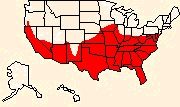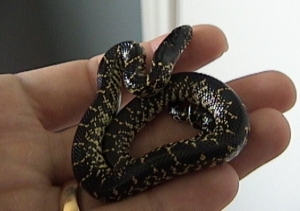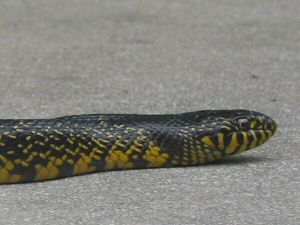|
Desert Kingsnake
|
- Order: Squamata (scaled reptiles)
- Suborder: Serpentes (snakes)
- Family: Colubridae ("typical" snakes)
- Subfamily: Colubrinae ("typical"
snakes)
- Genus: Lampropeltis (kings and
milksnakes)
|
|
Scientific Name: Lampropeltis
getula splendida Baird & Girard, 1853 |
| Habitat: Typical
habitat consists of fields and other open areas with sufficient
cover. |
Lampro="shiny," pelta="shield"
(scales) getulus=erroneously referring to an area in North
Africa, splendida="splendid" (pattern)
|
| Length: May attain a
total length of 5 feet or more. |
Old Scientific Name(s):
Lampropeltis getulus splendida; specific name changed to
match "gender" of generic name |
| Food: In captivity, my
specimen has ate green anoles, Mediterranean geckos, and pinkie
mice. Wild individuals of this species will also eat other
snakes, including rattlesnakes. |
 |
|
I removed this snake from a family's house in
August 2002. They had mistaken it for a rattlesnake, because
it had coiled up and was vibrating its tail, a common defense for
many nonvenomous snakes (the rationale being that if the snake is
in dry leaves and rattles its tail, the resulting sound mimics the
familiar rattling sound of the rattlesnake--discouraging
predators). |
 |
| I had this snake only one year
before it died of unknown causes. I was looking forward to
having it for years to come, as kingsnakes make excellent
pets--taming quickly and very tolerant of handling. |
 |
|
At right is a picture of an adult female desert
king I removed from a girl's bedroom in 2004. I suspect the
king wandered into the house after picking up the scent of the
girl's pet ferret--I found it near the ferret's cage. |
 |
|
|
|
|
|